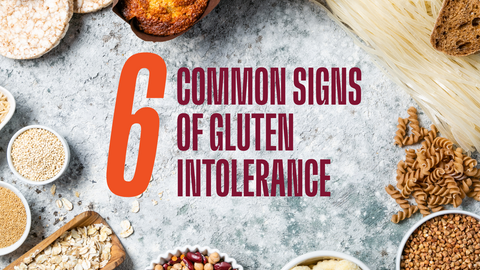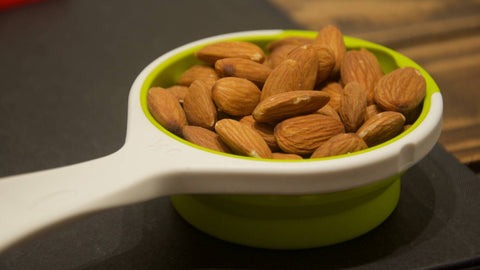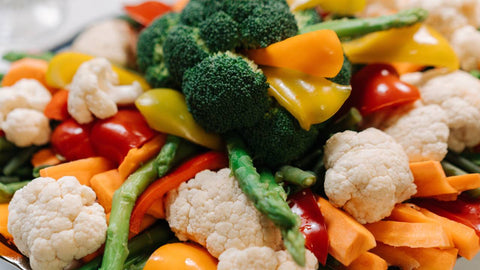Gluten intolerance is a common and debilitating dietary condition that affects 1 in 70 Australians. Scarily, estimates suggest that of this number, 80% aren’t diagnosed.
That means they are struggling with the effects of gluten intolerance without realising it’s what they eat that makes them sick.
If you’re reading this, and you aren’t sure if you suffer from a gluten intolerance, this article will discuss 6 common signs of gluten intolerance and 6 foods that trigger reactions.
What is Gluten Intolerance?

Gluten intolerance is also commonly referred to as Celiac disease. Celiac disease occurs when the body’s immune system reacts abnormally to gluten, which damages the small bowel. Over time, the surface areas of the bowel shrinks, meaning sufferers are less able to absorb nutrients and process food properly.
While Celiac disease is the most serious form of gluten intolerance, non-Celiac gluten sensitivity and wheat allergies can also cause symptoms, but usually to a lesser degree.
Can You Become Gluten Intolerant Later in Life?
One of the myths about gluten intolerances is that you have to be born with them. Unfortunately, this misconception causes many people to remain undiagnosed because they don’t think it’s possible for them to have it.
Gluten intolerance can appear in people of any age, even those who have never had issues with gluten before. In fact, evidence suggests that gluten intolerance may actually become more likely as we age.
6 Common Signs of Gluten Intolerance

So, if you suspect you have a gluten intolerance, you might be wondering if there are any common signs or symptoms.
1. Irregular bowel movements
Irregular bowel movements are probably the most common sign of gluten intolerance. Because the bowel can’t process gluten-rich foods properly, bouts of constipation and diarrhoea are common. Constant diarrhoea causes electrolyte loss and even dehydration if it’s severe enough.
2. Fatigue
Gluten intolerance can cause fatigue for two main reasons. The first is because your body will naturally get more tired when it can’t absorb enough required nutrients. The second is because the chronic pain and nausea caused by a gluten intolerance is mentally exhausting and can interrupt sleep.
3. Stomach Pain, Nausea and Bloating
Stomach pain and nausea are common complaints for gluten intolerant people. Both of these signs are usually caused by bloating, which is when gases caused by the digestion process become trapped, leading to a painful feeling of fullness.
4. Skin Reactions
One of the more distressing signs of a gluten intolerance are skin reactions. Dermatitis herpetiformis is a skin condition that causes itchy, painful blisters. Unfortunately, many people have their dermatitis herpetiformis mis-diagnosed as eczema, despite it being mostly curable by adopting a gluten-free diet.
5. Unintentional Weight Loss
If you are losing weight without making an intentional effort to do so, this could be a sign of a gluten intolerance. The combination of decreased nutrient absorption and increased bowel movements can mean that gluten intolerant people don’t receive enough energy from what they eat to sustain them.
6. Pain or Numbness in the Limbs
Gluten can affect a person’s limbs in several strange ways. Gluten intolerance is suspected to be responsible for increased levels of joint and muscle pain. Medical scientists think gluten intolerance, neuropathy and genetically determined hypersensitive nervous systems are linked. That means gluten intolerant people are simultaneously more sensitive to pain, while also experiencing numbness.
Non-Celiac Gluten Sensitivity and Wheat Allergies
Non-Celiac gluten sensitivity and wheat allergies are also conditions caused by gluten, and they share the 6 signs mentioned in this list. The difference is, their symptoms are usually milder. However, there are three exceptions that are worth discussing.
Brain Fog
Brain fog is a common complaint from non-Celiac gluten sensitivity sufferers. While it’s very hard to explain or diagnose, brain fog causes people to be forgetful, lose concentration and have trouble making simple decisions.
Nasal Congestion
Nasal congestion is a sign of a wheat allergy. Many allergies cause nasal problems, and wheat is no different. Sufferers often report having a runny nose, sneezing and nasal congestion after eating gluten.
Anaphylaxis
For a very small percentage of people allergic to wheat, anaphylaxis is a serious concern. When wheat enters their body, their immune system overreacts and causes them to enter a state of shock. Shock can be fatal if left untreated.
6 Common Foods that Trigger Gluten Intolerance


Now that you know the signs of a gluten intolerance, that isn’t going to help you much if you don’t know which foods to avoid. That’s why we’ve provided this handy list of gluten foods to avoid!
Important Note: Many of these foods have gluten free equivalents, or their gluten content may vary from brand to brand. To be safe, and to avoid giving up foods you love, learn about 10 gluten free substitutes for your household staples.
Oats and Cereal
Oats by themselves don’t contain gluten, but unfortunately they are often processed in the same places as other grains and cereals that do contain gluten. Likewise, most cereals contain wheat which is one of the most important gluten containing ingredients to avoid, especially for those with a wheat allergy.
Bread and Wraps
Almost all breads and wraps contain wheats unless they are explicitly labelled gluten free. Like oats, even if they don’t list gluten as a primary ingredient, most bread is manufactured in areas where other gluten products are also made.
Crackers
Just like bread, crackers are often made with wheat. Unlike bread, there are plenty of alternatives to wheat crackers, such as rice-based crackers instead.
Pasta and Spaghetti
Most pasta is wheat based, which means it’s a no go for people with a gluten intolerance. That also goes for many kinds of spaghetti and noodles as well.
Condiments
Condiments, like sauces and gravies, are common sources of gluten. While many gluten intolerant people manage to eat gluten-free meals, it’s easy to accidentally put some sauce on them - not realising the harm it can cause. In particular, soy sauce and other marinades from Asian cuisines are particularly risky.
Beer
For many of you, this might be the hardest thing on this list to go without! Unfortunately beer contains barley, which is a grain rich in gluten. So if you’ve fixed your diet and are still feeling unwell, it might just be the well-deserved beer at the end of the day that is behind it.
How Probiotics Restore Good Gut Health
While eliminating gluten from your diet will definitely help you avoid the debilitating signs of gluten intolerance, there is something else you can do.
Probiotics are live bacteria and yeast that people ingest to improve the health of their digestive systems. While the idea of eating live bacteria may sound gross, your body actually depends on a delicate balance of bacteria, and probiotics can help restore this balance if you are having digestion issues.
Studies have shown that probiotics may be good for people with a gluten intolerance. While a gluten intolerant person’s body may not be able to process gluten on its own, probiotics enzymes can help break down gluten for them.
Probiotic research is still in its infancy, but it does offer a light at the end of the tunnel for gluten intolerant people.
Activate Foods
There’s no doubt that living a gluten free lifestyle is difficult. It takes a lot of research, discipline and time combing the grocery aisles for gluten-free ingredients.
That’s why Activate Foods is the perfect option for any gluten intolerance sufferer. We have a constantly changing menu of delicious, fresh made gluten free ready meals. You can enjoy great food without the inconvenience of needing to know whether they are gluten free or not. We also have the blog 10 Gluten Free Substitutes For Your Household Staples which can provide a list of gluten-free options for commonly used household staples.
For more information, visit our website.
If you want to order your first round of Activate Foods, register today!


